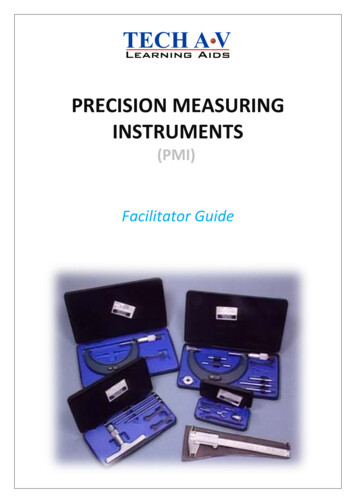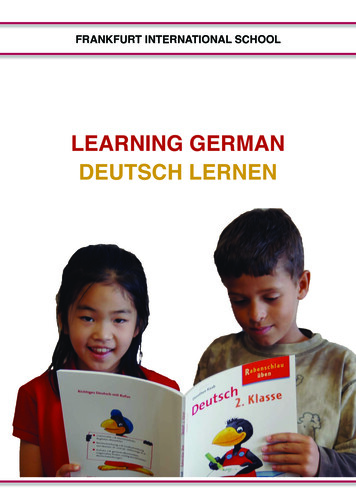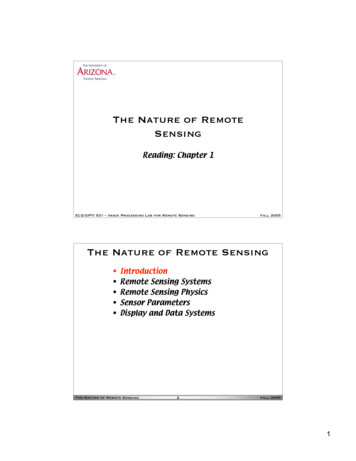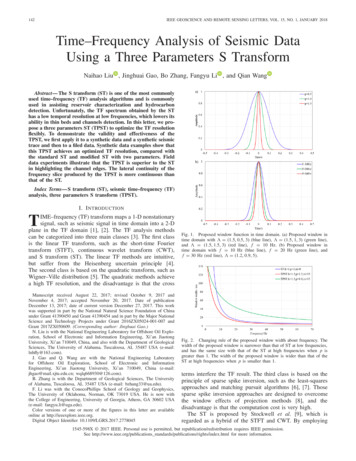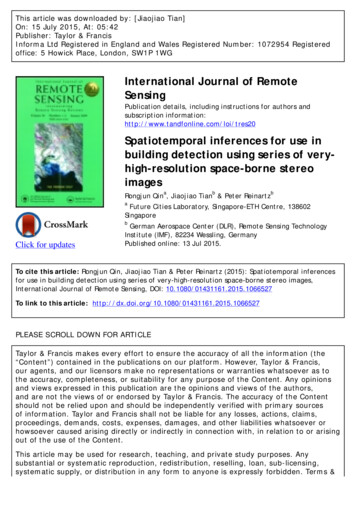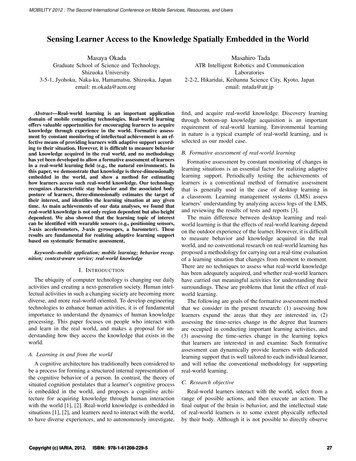
Transcription
MOBILITY 2012 : The Second International Conference on Mobile Services, Resources, and UsersSensing Learner Access to the Knowledge Spatially Embedded in the WorldMasaya OkadaMasahiro TadaGraduate School of Science and Technology,Shizuoka University3-5-1, Jyohoku, Naka-ku, Hamamatsu, Shizuoka, Japanemail: m.okada@acm.orgATR Intelligent Robotics and CommunicationLaboratories2-2-2, Hikaridai, Keihanna Science City, Kyoto, Japanemail: mtada@atr.jpAbstract—Real-world learning is an important applicationdomain of mobile computing technologies. Real-world learningoffers valuable opportunities for encouraging learners to acquireknowledge through experience in the world. Formative assessment by constant monitoring of intellectual achievement is an effective means of providing learners with adaptive support according to their situation. However, it is difficult to measure behaviorand knowledge acquired in the real world, and no methodologyhas yet been developed to allow a formative assessment of learnersin a real-world learning field (e.g., the natural environment). Inthis paper, we demonstrate that knowledge is three-dimensionallyembedded in the world, and show a method for estimatinghow learners access such real-world knowledge. Our technologyrecognizes characteristic stay behavior and the associated bodyposture of learners, three-dimensionally estimates the target oftheir interest, and identifies the learning situation at any giventime. As main achievements of our data analyses, we found thatreal-world knowledge is not only region dependent but also heightdependent. We also showed that the learning topic of interestcan be identified with wearable sensors (e.g., positioning sensors,3-axis accelerometers, 3-axis gyroscopes, a barometer). Theseresults are fundamental for realizing adaptive learning supportbased on systematic formative assessment.Keywords–mobile application; mobile learning; behavior recognition; context-aware service; real-world knowledgeI. I NTRODUCTIONThe ubiquity of computer technology is changing our dailyactivities and creating a next-generation society. Human intellectual activities in such a changing society are becoming morediverse, and more real-world oriented. To develop engineeringtechnologies to enhance human activities, it is of fundamentalimportance to understand the dynamics of human knowledgeprocessing. This paper focuses on people who interact withand learn in the real world, and makes a proposal for understanding how they access the knowledge that exists in theworld.A. Learning in and from the worldA cognitive architecture has traditionally been considered tobe a process for forming a structured internal representation ofthe cognitive behavior of a person. In contrast, the theory ofsituated cognition postulates that a learner’s cognitive processis embedded in the world, and proposes a cognitive architecture for acquiring knowledge through human interactionwith the world [1], [2]. Real-world knowledge is embedded insituations [1], [2], and learners need to interact with the world,to have diverse experiences, and to autonomously investigate,Copyright (c) IARIA, 2012.ISBN: 978-1-61208-229-5find, and acquire real-world knowledge. Discovery learningthrough bottom-up knowledge acquisition is an importantrequirement of real-world learning. Environmental learningin nature is a typical example of real-world learning, and isselected as our model case.B. Formative assessment of real-world learningFormative assessment by constant monitoring of changes inlearning situations is an essential factor for realizing adaptivelearning support. Periodically testing the achievements oflearners is a conventional method of formative assessmentthat is generally used in the case of desktop learning ina classroom. Learning management systems (LMS) assesslearners’ understanding by analyzing access logs of the LMS,and reviewing the results of tests and reports [3].The main difference between desktop learning and realworld learning is that the effects of real-world learning dependon the outdoor experience of the learner. However, it is difficultto measure behavior and knowledge acquired in the realworld, and no conventional research on real-world learning hasproposed a methodology for carrying out a real-time evaluationof a learning situation that changes from moment to moment.There are no techniques to assess what real-world knowledgehas been adequately acquired, and whether real-world learnershave carried out meaningful activities for understanding theirsurroundings. These are problems that limit the effect of realworld learning.The following are goals of the formative assessment methodthat we consider in the present research: (1) assessing howlearners expand the areas that they are interested in, (2)assessing the time-series change in the degree that learnersare occupied in conducting important learning activities, and(3) assessing the time-series change in the learning topicsthat learners are interested in and examine. Such formativeassessment can dynamically provide learners with dedicatedlearning support that is well tailored to each individual learner,and will refine the conventional methodology for supportingreal-world learning.C. Research objectiveReal-world learners interact with the world, select from arange of possible actions, and then execute an action. Thefinal output of the brain is behavior, and the intellectual stateof real-world learners is to some extent physically reflectedby their body. Although it is not possible to directly observe27
MOBILITY 2012 : The Second International Conference on Mobile Services, Resources, and UsersAdvanced learning support based onformative assessment of real-world learningUtilization as context informationLearning situationimportantlearningplace ofinterestlearningtopicEstimation by information integrationPhysical Estimation by signal processingSensor dataLPSFig. 1.GPSacceler-ometergyroscope barometerEstimating learning situation by sensing physical behavior.the thinking process of learners, their interaction with theworld can be observed from outside, and can be a clue tounderstanding learning situations.Real-world learners use their body to interact with thesurroundings, and in this way obtain knowledge about theworld. A learner’s body can be considered to be a sensorfor obtaining information about the real world, and also anactuator for manipulating the world. Therefore, in the presentresearch, as a fundamental approach for achieving advancedintellectual support based on systematic formative assessmentof real-world learning, we developed a sensing technology thatcan identify the behavior of real-world learners, and estimatethe nature of their intellectual activity in real time. Thesystem recognizes physical behavior using low-level signalprocessing, integrates the recognition results, and thus formsan understanding of learning situations at a high level ofabstraction (Figure 1).D. Table of contentsSection II shows our sensing technique to precisely determine the time series of important learning activities in theworld. Section III focuses on the spatial structure of a realworld learning field, and demonstrates that knowledge is threedimensionally embedded in the world. Section IV proposesour sensing technology to determine the learning topic that alearner is examining, and to understand how learners accessknowledge that exists in the real world. Section V discussesour contribution and potential applications. Section VI concludes this paper with a brief summary of our achievements.II. T IME SERIES OF IMPORTANT LEARNING ACTIVITIESA. Important learning activities and unimportant activitiesDetermining how real-world learners carry out importantlearning activities is useful for forming an understanding ofCopyright (c) IARIA, 2012.ISBN: 978-1-61208-229-5how they access knowledge embedded in the world. Basedon past research [4], we can divide environmental learningactivities into two categories: important learning activities andunimportant activities. We can define important and unimportant activities as follows: Important learning activities– Observation: An activity for acquiring knowledgethrough interaction with the world (e.g., observationor survey focusing on a certain target, such astouching plants and soil, or writing field notes whileinspecting an observation target).– Knowledge exchange: A conversation activity forinteractively solving a problem through externalizingand exchanging knowledge (e.g., cooperative thinking through conversation and discussion). Trivialchat is not regarded as a knowledge exchange.– Intellectual investigation: The most important activity, involving simultaneous observation and knowledge exchange (e.g., cooperative thinking and discussion through a collaborative field survey). Physicaland internal experiences mutually influence eachother. Real-world knowledge embedded in a situation[1], [2] is maximally utilized by intellectual investigation. Unimportant activitiesLack of observation, lack of conversation, idle talk, rest,and so on.B. Determining intellectual activity through real-world behaviorThe time when a learner carries out a learning activity ismeaningful information for understanding knowledge acquisition. Although human behavior can be estimated from sensingdata [5], [6], [7], [8], [9], it is conventionally difficult toestimate the intellectual state of a learner by using sensors. Tobegin with, sensors are tools for measuring physical quantities(e.g., velocity, acceleration, angular velocity, signal strength)associated with body movement. Conventional research usessuch sensors to recognize human physical behavior. A typicalexample is identifying the location of humans at a given time[5]. Other examples include recognition of daily activities(e.g., walking, ascending stairs) [6], and abnormal activities(e.g., slipping on a wet floor) [7]. This has recently beenextended to the ability to sense human activities using consumer devices such as mobile phones [8], [9]. However, fewstudies have attempted to determine the relationship betweenthe physical behavior and intellectual state of humans. Hence,even if we measure real-world activities using sensors, it isquite difficult to infer the internal intellectual state of thelearner. Thus, we conducted field surveys to investigate therelationship between learner behavior and important learningactivities, and obtained the following significant results [10].1) When learners walk carelessly about in an environment,they rarely have enthusiastic discussions and obtain onlysuperficial information about the environment.28
MOBILITY 2012 : The Second International Conference on Mobile Services, Resources, and UsersUnimportantActivities1,001 sec.(12.86%)GPSreceiverObservation2,539 25 sec.(51.69%)KnowledgeExchange222 sec.(2.85%)Local PositioningSystem (LPS)Learners in the state of stable stayRecognition resultsSensing of real-world learningFig. 2.Automatic accurate identification of important learning activities (precision 87.14%).2) When learners engage in important learning activities(i.e., observation, knowledge exchange, intellectual investigation), they display a characteristic stay behavior.We call this behavior stable stay. Stable stay is definedas a condition that extends for Tt [sec] or more, in whicha fixed body posture is adopted (horizontal angular rotation of Tθ [deg/sec] or less) and movement is restrictedto a velocity of Tv [m/sec] or less. Stable stay includesthe state of crouching down. The learners in Figure 2are exhibiting stable stay behavior.3) When learners are not focused on a specific learningtopic and casually look around, their body orientationin the horizontal plane is not fixed, even if they are notwalking.C. Recognizing important learning activities by sensing stablestay conditionsUnder stable stay conditions, the possibility that importantlearning occurred was found to be 3.12 times higher thanfor other conditions [10]. On the grounds that importantlearning activities and stable stay conditions frequently cooccur [10], each learner was given a wearable local positioningsystem (LPS) (255 g, 111 x 82 x 39 mm, Figure 2) to beplaced on their lower back in order to determine the timeseries of important learning activities. The LPS is a sensorfor recording the local movement and body orientation of alearner. Important learning activities were identified based onthe detection of stable stay conditions with three thresholdparameters (Tt 15.00 [sec], Tv 0.10 [m/sec], Tθ 60.00[deg/sec]). These values were determined by pre-evaluatingsensor data for two experimental learners and inspecting thedata distribution of physical movements associated with bothimportant learning activities and unimportant activities. Thedata for these two learners were not used in the subsequentexperiments for evaluating the recognition accuracy.We evaluated the accuracy of the recognition method usingground-truth data for the time series of stable stay conditionsand important learning activities (18,000 sec; data for fivegroups representing 15 learners). As shown in the pie chart inFigure 2, the recognition results mostly fell into the importantCopyright (c) IARIA, 2012.ISBN: 978-1-61208-229-5Field area for learning718243569 10 11 12 13 1422 2315 16 17 18 19 20 2124 25 26 27 28 29 3031 32 33 3435 36 37 38 39 40 41 42 43 44 45 46 4748 49 50 51 52 53 54 55 56 57 58 5960 61 62 63 64 65 66 67 68 6970 71 72 73 74 75 7677 78 79 80Fig. 3.Region map of Kamigamo Experimental Forest, Kyoto University.learning category. We confirmed that the method could accurately recognize the time when important learning occurred(precision 87.14%) by automatically analyzing the LPS datafor the learners.III. K NOWLEDGE THREE - DIMENSIONALLY EMBEDDED INTHE WORLDA. Regional dependence of learning topicsAs shown in Figure 2, learners exhibit a wide variety ofbehavior such as looking at various parts of the environment,touching objects at various points with their hands, and observing objects while crouching down. However, whatever eachlearner actually notices, observes or investigates, stable staybehavior is commonly displayed when important learning activities are performed. This is an important finding concerningthe common structure of diverse learning activities.Important learning is a learning activity for accessingknowledge embedded in the real world. By sensing stablestay conditions, an accurate estimation can be made of howsuch important learning occurs in a learning field. Moreover,by tracing the location of learners with a GPS receiver,both the places of interest and the time spent engaged inimportant learning activities can be determined. Although thisis an advanced approach to determining the time sequence ofimportant learning activities, it is still difficult to estimate whata learner actually learns.29
MOBILITY 2012 : The Second International Conference on Mobile Services, Resources, and UsersADUpper layerAFEDECGMiddle layerBBEnhancement(A-G: learning topics)F2-Dimensional estimationLower layerGC3-Dimensional estimationFig. 4.Learner behavior in a natural ecosystem with a multi-layeredhierarchy.By identifying the targets on which important learningactivities are focused, we hope to be able to clarify theassociated content and the knowledge acquisition process.Here, if “what is learned” is related to “the position of thelearner”, the range of learning topics can be narrowed downbased on location. To determine whether this is the case, weconducted experiments in a part (130 x 50 m; Figure 3) ofKamigamo Experimental Forest, Kyoto University, with 15learners in March, 2010. We found that the learners considereda total of 142 topics. These included, for example, “thesymbiotic relationship between mushrooms and moss”, and“the relationship between pinecone features and the growthenvironment of pine trees.” We divided the field using a10 x 10 m grid, and defined 80 different regions (Figure3). We found that the topics that the learners consideredtended to depend on their location. Specifically, on average,each topic was considered in 1.71 regions, and 2.16 topicswere considered per region. The topics and the locations areclosely related, which illustrates the uniqueness of the physicalinformation in each region.B. Height dependence of learning topicsBased on the regional dependence of the learning topics, two-dimensional (2D) positional information is usefulfor narrowing down possible learning topics. However, inregions where more than one learning topic exists, 2D placeinformation is insufficient to uniquely identify the topic ofinterest. We therefore need to consider additional informationfor the determination of learner context. We note that a naturalecosystem generally has a multi-layered hierarchy. As shownin Figure 4, learners behave differently even if they stayin the same place. They sometimes look up and sometimescrouch down, and their posture changes according to thelearning topics that they consider. We therefore performed a3D classification of the 142 topics learned in the experiment.We found that the topics were not only region dependentbut also height dependent and could be categorized into thefollowing three layers: Upper layer: Objects above the level of the learners’heads (e.g., tall trees, branches and leaves, light sources).The topics in this category are often examined when alearner is looking up. Middle layer: Objects at eye level (e.g., tree trunks,Copyright (c) IARIA, 2012.ISBN: 978-1-61208-229-5Fig. 5.3D determination of the learning topics that a learner examines.head position 1head position 2lookingupFig. 6.lookingstraightcrouchingdownObservation target and posture.bushes). The topics in this category are often examinedwhen a learner is looking straight ahead. Lower layer: Objects at ground level (e.g., mushrooms,moss, soil, undergrowth, aerial roots, mountain stream,pond). The topics in this category are often examinedwhen a learner is looking down or crouching down.What a learner examines depends on the region, and eachregion offers only a small number of topics. Moreover, thisresearch also found that each layer of an ecosystem containsdifferent knowledge, and height is therefore another factorinfluencing the knowledge that a learner can obtain. Even ifmore than one topic occurs in the same region, we found thatheight information is useful for distinguishing such topics. Ifthe learning topics cannot be distinguished in a 2D space, itis possible to distinguish them in a higher 3D space (Figure5).IV. D ETERMINING THE CURRENTLY EXAMINED TOPICStable stay is a condition that is defined in a horizontal 2Dplane and can be used for robust identification of an importantlearning activity. As discussed in Subsection III-B, the postureof learners reflects their interests at that time. We thereforeextended the technique for recognizing stable stay behaviorto also identify the posture involved, thus allowing the 3Dposition of the topic of interest to be determined.A. Wearable sensorsUsing an eye-mark recorder, it might be feasible to trackthe gaze direction of a learner. However, such devices arecurrently large and heavy, and restrict the movement of learners. Furthermore, when learners move, their location and headdirection constantly change without constraint. This makes itdifficult to use data from an eye-mark recorder for automatic30
MOBILITY 2012 : The Second International Conference on Mobile Services, Resources, and Usersstanding uprightydiscrimination function is defined by the below formula.bending downxxyHybrid sensor witha 3-axis accelerometer,a 3-axis gyroscope,and a barometerzzf (ϕ(x)) zyyxzxGravitational acceleration and learner’s posture.determination of what is being observed. On the other hand,it is known that head direction and gaze direction are closelyrelated, so that head direction can be substituted for gazedirection [11]. For example, as shown in Figure 4 and Figure6, to observe objects at ground level, learners need to crouchor bend their head down. A learner who is crouching downhas a different head height to one who is standing upright(Figure 6). Thus, we classified a learner’s posture (e.g., lookingstraight ahead, looking up, looking down, crouching down)based on head height and body tilt. Each learner was providedwith wearable-type hybrid sensors shown in Figure 7 (headand body), in addition to a LPS (lower back) and a GPS(head) for sensing stable stay conditions. The hybrid sensor(22g, 37 x 46 x 12 mm) has a 3-axis accelerometer (50Hz),a 3-axis gyroscope (50Hz), and a barometer (25Hz) builtin. The accelerometers are for obtaining 3D tilt information,and the barometers are for obtaining height information. Thegyroscopes are for obtaining 3D information on the rotationof a learner’s body and head.B. Estimating postureWhen designing a classifier for recognizing human behavior,it is first necessary to understand the typical characteristics ofsensor data associated with each of the target behaviors. Thus,we investigated the sensor data obtained in our experiments.As shown in Figure 7, when a learner stands upright and islooking straight ahead, the output from the vertical axes ofthe accelerometers (i.e., the x-axis of the body sensor, the zaxis of the head sensor) should almost equal the gravitationalacceleration (1000 mG). On the other hand, when the bodyand head of a learner tilts, the accelerometers also tilt. Whenthe body and head rotate about the y-axis, the gravitationalacceleration is split into two components along the x-axisand z-axis. For example, as shown in Figure 8, the sensoroutput exhibits different characteristics when a learner displaysdifferent target behaviors (e.g., looking up, standing upright,crouching down). Thus, acceleration data are useful for determining body posture. Data on air pressure and angular velocityare also useful for measuring head position and body rotation.We are currently in the process of implementing sucha body posture identification technique. The integration ofmultimodal sensor data is carried out using a machine learningmethod such as a support vector machine (SVM), which canachieve a high generalization performance. The non-linearCopyright (c) IARIA, 2012.ISBN: 978-1-61208-229-5αi yi K(x, xi ) b(1)i 1( : gravitational acceleration)Fig. 7.n K(x, xi ) is a kernel function, and we used the followingGaussian kernel: x xi 2)(2)σ2C is the soft margin parameter, and α are Lagrange multipliers. Machine learning in a feature space is carried out bysolving the following optimization problem under constraints:K(x, xi ) exp ( maxαn αi i 1Subject ton1 αi αj yi yj K(xi , xj )2 i,j 10 αi C,n αi yi 0(3)(4)i 1V. D ISCUSSIONOur essential interest centers on understanding how knowledge is generated and develops in the real world. The aimof the present research is to make it possible to observe theprocess by which intellectual activities occur and progressin a real-world learning field, and to assess such activitiesusing an objective standard. Although recognition of physicalbehavior can be approached using a machine learning method,it is conventionally difficult to estimate the correspondingintellectual state. This is because there is a wall betweenunderstanding superficial-level behavior and the internal-levellearning situation. An essential difficulty is that the correlationbetween physical behavior and the intellectual state is notknown.In order to overcome this difficulty, we have proposed a newapproach for sensing intellectual behavior by the complementary use of information on human activity and the spatial structure of the learning field. First, we noted the role of a learner’sbody as an interactive medium for obtaining knowledge fromthe surroundings. Thus, we investigated a characteristic staybehavior that can effectively identify situations during whicha learner is engaged in important learning activity. We alsoshowed a method for automatically recognizing the occurrenceof such behavior using signal processing.Second, this research confirmed the 2D regional dependenceof learning topics in a real-world learning field, and showedthat each region offers only a small number of topics. Theresearch also focused on the 3D spatial structure of the field,i.e., the vertical distribution of an ecosystem in a multi-layeredhierarchy. The results indicated that each layer contains different knowledge, and height is an important factor influencingthe knowledge that a learner can obtain. Even if more thanone topic occurs in the same region, we found that heightinformation can be used to uniquely distinguish the topic beinglearned. We also consider the possibility of classifying human31
MOBILITY 2012 : The Second International Conference on Mobile Services, Resources, and 0time [hh:mm:ss.xxx]acceleration [mG]acceleration 0-100013:00:37.501time [hh:mm:ss.xxx]Fig. 8.13:00:38.941body (crouching down)0-100013:08:00.70113:00:38.221time [hh:mm:ss.xxx]xyz500time [hh:mm:ss.xxx]13:00:38.22113:00:38.941time [hh:mm:ss.xxx]Learner acceleration data for different target behaviors.posture with respect to the vertical direction using a machinelearning technique to three-dimensionally identify the learner’stopic of interest.This paper examined relationship among the human body,intelligence, and the environment by investigating real-worldlearning as a model case. Although many studies have beencarried out on groupware, learning support, and ubiquitouscomputing, it is an unsolved and important problem to estimate intellectual situations at a high level of abstraction byintegrating the results of low-level signal recognition.It is hoped that our approach will act as a core for realizingan advanced service for context-aware learning support. Forexample, it could identify learning objects whose existence isoverlooked or whose value is not discovered. This techniquecould identify 3D locations where knowledge has not yet beenfound, and could selectively encourage a learner to be awareof potential information. Moreover, numerical indices couldbe generated of how diversely and actively a learner studied,which are useful for assessing intellectual activity in real-worldlearning fields.VI. C ONCLUSION AND F UTURE WORKTo enhance human intellectual activity, it is important tounderstand how humans acquire and process knowledge. Thispaper focused on people who interact with their surroundings and learn from them, and a method was proposed forunderstanding how they access knowledge that exists in thereal world. It involves automatically sensing particular staybehavior that occurs during important learning activities. Inaddition to the regional dependence of learning topics, itCopyright (c) IARIA, 2012.0-100013:00:37.50113:08:54.781xyz500body (standing upright)xyz50013:08:27.7411000time [hh:mm:ss.xxx]body (looking up)1000xyz500-100013:08:00.70113:01:17.961head (crouching down)acceleration [mG]500acceleration [mG]acceleration [mG]1000head (standing upright)acceleration [mG]head (looking up)ISBN: 978-1-61208-229-5also takes into account the spatial structure of the learningfield, i.e., the vertical distribution of an ecosystem in a multilayered hierarchy. We found that each layer of an ecosystemcontains different knowledge, and height is an important factorinfluencing the knowledge that a learner can obtain. We foundthat height information can be used to uniquely distinguishthe topic being learned. We also discussed the possibility ofidentifying the learning topic of interest based on the bodyposture of the learner. Our challenge is to develop a methodof estimating the intellectual state of the learner at a high levelof abstraction using low-level signal data, and integrating therecognition results.The rapid progress being made in engineering technologieshas led to new ways of innovating learning support. Ourintention is not to select engineering technologies that fitconventional methodologies, nor to replace old educationaltools with new ones. Our challenge is instead to create aneffective method of learning support that can be embodied onlyusing the innovation of computational power. Our researchis fundamental for achieving a practical understanding of thedynamics of human knowledge processing and promoting newintellectual activity in a next-generation ubiquitous society.ACKNOWLEDGEMENTSThe authors thank the staff at Kamigamo ExperimentalForest, Kyoto University, who supported our experiments. Thisresearch was funded by a Grant-in-Aid for Young Scientists(B) (22700121) of MEXT.32
MOBILITY 2012 : The Second International Conference on Mobile Services, Resources, and UsersR EFERENCES[1] J. S. Brown, A. Collins, and P. Duguid, “Situated cognition and theculture of learning,” Educational Researcher, vol. 18, no. 1, pp. 32–42,1989.[2] J. Lave and E. Wenger, Situated Learning: Legitimate Peripheral Participation. Cambridge, UK: Cambridge University Press, 1991.[3] T. Okamoto, N. Nagata, and F. Anma, “The knowledge circulatedorganisational management for accomplishing e-learning,” KnowledgeManagement & E-Learning, vol. 1, no. 1, pp. 6–17, 2009.[4] T. Mizukoshi and T. Kihara, Creation of New Environmental Education(in Japanese). Kyoto: Minerva Syobou, 1995.[5] O. Türkyilmaz, F. Alagöz, G. Gür, and T. Tugcu, “Environment-awarelocation estimation in cellular networks,” EURASIP Journal on Advancesin Signal Processing, vol. 2008, pp. 139:1–139:9, January 2008.[6] J. Lester, T. Choudhury, and G. Borriello, “A practical approach torecognizing physical activities,” PERVASIVE2006, vol. LNCS3968, pp.1–16, 2006.[7] J. Yin, Q. Yang, and J. J. Pan, “Sensor-based abnormal human-activitydetection,” IEEE Transactions on Kn
Sensing Learner Access to the Knowledge Spatially Embedded in the World Masaya Okada Graduate School of Science and Technology, Shizuoka University 3-5-1, Jyohoku, Naka-ku, Hamamatsu, Shizuoka, Japan . learning situations is an essential factor for realizing adaptive learning


